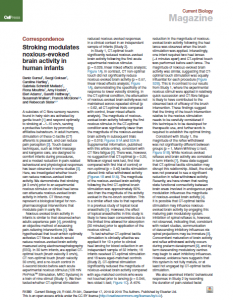
A subclass of C fibre sensory neurons found in hairy skin are activated by gentle touch and respond optimally to stroking at ∼1–10 cm/s, serving a protective function by promoting affiliative behaviours. In adult humans, stimulation of these C-tactile (CT) afferents is pleasant, and can reduce pain perception. Touch-based techniques, such as infant massage and kangaroo care, are designed to comfort infants during procedures, and a modest reduction in pain-related behavioural and physiological responses has been observed in some studies. Here, we investigated whether touch can reduce noxious-evoked brain activity. We demonstrate that stroking (at 3 cm/s) prior to an experimental noxious stimulus or clinical heel lance can attenuate noxious-evoked brain activity in infants. CT fibres may represent a biological target for non-pharmacological interventions that modulate pain in early life.